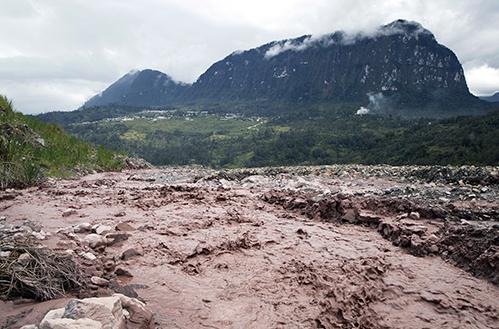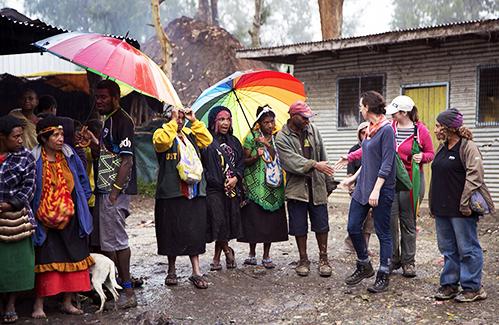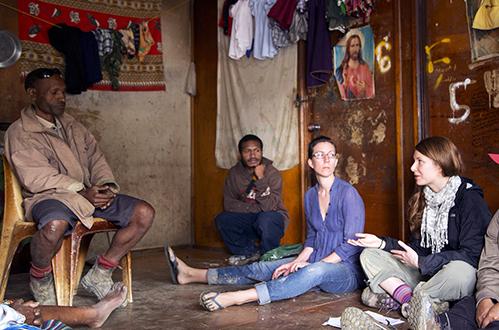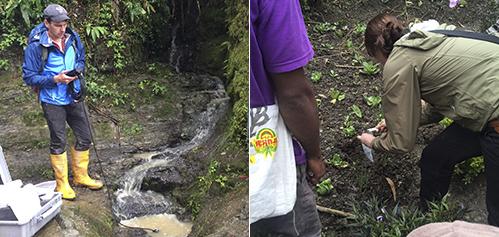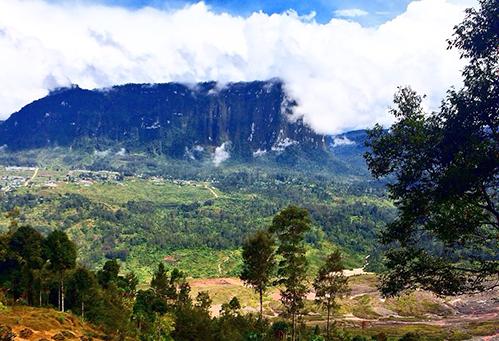Human Rights Clinic Teams with Scientists to Investigate Conditions at Gold Mine in Papua New Guinea
An Innovative Interdisciplinary Columbia University Study Provides Indigenous Communities with an Independent Assessment of Environmental Risks
New York, February 2, 2015—A team of Columbia Law School students and faculty spent the winter recess in the remote highlands of Papua New Guinea working alongside scientists to investigate allegations of human rights abuses and environmental degradation at one of the region’s largest gold mines.
Thousands of indigenous people live near the Porgera mine, majority-owned by Canadian corporation Barrick Gold. The indigenous community fears that mine operations have polluted their rivers and streams, contaminated rainwater, caused erosion and landslides, and contributed to poor air quality and low crop yield. While residents are concerned, they say that they have had little access to independent assessments of possible environmental risks.
| Tailings waste from the mine flows through the Porgera Valley in Papua New Guinea’s remote Enga Province. Photo: Emily Allen |
“It was shocking to see how close people actually live to the mine,” said Stephanie Persson ’15, one of four Human Rights Clinic students who helped carry out the study. “In some of the areas we hiked through, villages are jammed in right alongside the mine’s waste dumps. Some homes are so close that they shake when there is blasting at the mine. Children even play in the liquid waste that flows out from the mine site.”
The Columbia University research team designed an interdisciplinary rights-based study to respond to the indigenous community’s requests for an independent assessment of the mine’s environmental and human rights impacts. This unique approach blended physical science and human rights methods and perspectives. The study was led by Columbia Law School Professor Sarah Knuckey, director of the Human Rights Clinic; Joshua Fisher, director of the Advanced Consortium on Cooperation, Conflict, and Complexity (AC4) at the Earth Institute, Columbia University; and Penn State University Professor Tess Russo.
Professor Sarah Knuckey and Human Rights Clinic student Holly Stubbs '15 greet Porgera Valley residents. Photo: Emily Allen. |
“The complexity of the problem could only be tackled by bringing together experts in human rights, land use, water science, and environmental conflict,” said Knuckey, the Lieff Cabraser Associate Clinical Professor of Law. “By partnering with scientists, we aimed to gain a deeper understanding of the mine’s impacts on the rights to water, food, and health. In addition to providing independent information to the communities living around the mine, we hope this study can push forward the use of mixed-methods investigations in the human rights field.”
Fisher said the study’s scientific analysis will be based on water samples obtained from households, streams, and rivers adjacent to the mine, as well as soil samples obtained near rivers and residents’ homes. “In combination with interviews conducted by the Human Rights Clinic, this data will enable us to understand how any metals and chemicals released from the mine site travel into the surrounding ecosystem and potentially impact the communities living around the mine,” Fisher said.
| Knuckey, second from right, and Human Rights Clinic student Alison Borochoff-Porte '15, right discuss local conditions with Porgera residents. Photo: Emily Allen. |
Communities around the world struggle with the impacts of mining, and are looking for ways to understand and improve conditions. “The unique mixed-method approach we are using in Papua New Guinea is an innovative way to work with communities to understand and mitigate the risks associated with heavy metal contamination,” said Fisher. “It could serve as a prototype for other mining-impacted communities.”
Human Rights Clinic student Alison Borochoff-Porte ’15 said the local residents she interviewed were very concerned about their environment.
“People repeatedly told me that they think their local streams are poisoned. During the dry season, many people say they walk for hours to access sources of drinking water,” she said. “We hope this study will support the indigenous communities in their desire to understand any environmental impacts of the mine and in their efforts to ensure a healthy environment for future generations.”
| Dr. Joshua Fisher tests water near the mine, left, and Human Rights Clinic student Stephanie Persson ’15 takes a soil sample from a resident’s garden. Photos: Sarah Knuckey |
The interdisciplinary team will return to Papua New Guinea later this year to share their findings with local communities. They will also publish the results of their research, with the twin aims of guiding future environmental and human rights studies, and advocating for improved conditions on the ground.
The study was carried out with funding from the Columbia Law School Human Rights Clinic, and through a grant from the Earth Institute. Also participating were: Columbia Law School Clinical Teaching Fellow Benjamin Hoffman and clinic students Genevieve Taylor ’15 LL.M, and Holly Stubbs ’15. The team partnered with researchers from the University of Papua New Guinea and was also accompanied by a photographer and filmmaker, Emily Allen, who documented the research, and recorded testimony of local residents.
Through human rights clinics, Knuckey has worked on human rights issues related to the Porgera gold mine for the past eight years. Previous clinic work focused on alleged abuses—killings, rapes, and beatings—by security personnel employed at the mine site. During that prior work, local residents voiced concerns about their living conditions, and requested that Knuckey expand clinic work to encompass environmental, economic, social, and cultural rights issues.
The research team hiked for hours each day to reach villages around the Porgera mine site. Photo: Sarah Knuckey. |
# # #
The Human Rights Clinic is an intensive year long course directed by Sarah Knuckey, the Lieff Cabraser Heimann and Bernstein Clinical Associate Professor of Human Rights and the faculty co-director of the Human Rights Institute at Columbia Law School, as well as by Clinic Fellow Benjamin Hoffman. The Clinic brings together human rights work, student education, critical reflection, and scholarly research. Students are trained to be strategic human rights advocates, while pursuing social justice in partnership with civil society and communities, and advancing human rights methodologies and scholarship.
